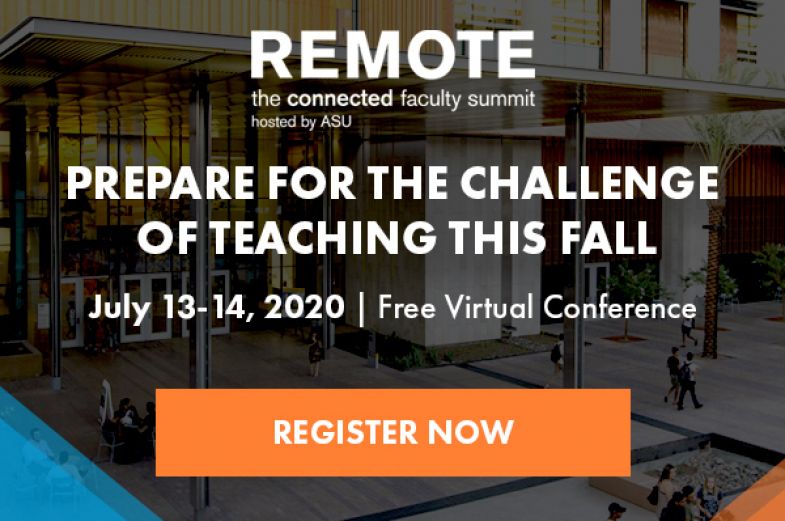The coronavirus pandemic has caused widespread disruption to higher education across the globe. But, for Michael Crow, regarded as one of the most reform-minded university presidents in the US, it is just one of many shocks that the sector must come to terms with.
“Covid is just a sign of global complexity, a sign of global interconnectedness,” said Professor Crow, president of Arizona State University, which will next month be hosting a virtual conference on online education with Times Higher Education as a partner. “It’s a shock, a negative shock, but there are also other shocks that will be both negative and positive [such as] technological advancement and automation replacing many jobs.
“Every lorry on every motorway in the entire UK is going to be driven by a robot at some point. What does that mean? That means that humans may be free, if educated and if empowered, to now do new things.”
The problem, according to Professor Crow, is that universities are largely centred on one model of learning.
“The 21st century is going to be increasing in speed in terms of acceleration of change, globalisation, and disruption of all types – social, economical, technological, biological,” he said. “And you tell me whether the average college [where] faculty sit around in rooms and [wear] dark robes [is] going to be the best way to educate in a full-scale democracy going forward.
“I would say it’s a necessary but insufficient modality. We need new modalities, new ways of teaching, new ways of creating learning environments. Covid has now brought all this to the forefront in real time.”
The disruption caused by Covid-19 is a chance for public universities to truly democratise access to higher education, differentiate their offering and cooperate more deeply with each other, he said.
While the expansion of higher education in the UK and US over the past 200 years has increased access to university, the rate of democratisation is simply “too slow” and therefore the university systems have done an “inadequate job of social empowerment”, Professor Crow argued.
Learn how to deliver effective and engaging online experiences for students. Register for free to attend the virtual conference REMOTE
“We bring students to these faculties but only certain students can go and you can only go when you’re 17, 18, 19 years old,” he said. “What I think we’re seeing now is that technology…is a way to take the same faculty and the same learning environment and to expand it, to project it.”
Arizona State University now operates in “three simultaneous modalities”: a blended learning approach called “full immersion on campus”; an asynchronous online approach called “digital immersion”, which generally caters for students who are in employment; and a third approach, which has been built since Covid-19, known as “full immersion synchronous”, in which students learn in real time but are not on campus. The institution has about 70,000 full immersion students, and a similar number enrolled in a digital immersion programme.
All three realms include a component of “technology-enhanced learning” in order to effectively teach students from a diverse range of backgrounds, but Professor Crow said it is a “misnomer” to call the new approach taken in the wake of coronavirus “online learning”.
“This isn’t online learning. This is full immersion – I can see you,” he said, referring to faculty-student working relations.
And while many universities have an online learning model akin to Arizona State’s digital immersion approach, many do not use their “regular faculty” for these courses, he added.
“We’re going to be operating in the fall semester in all three modes at the same time,” said Professor Crow. “We’re going to have students on campus in highly healthy structures with testing and masking and all kinds of other things, then we’ll have some students synching in and synching out, and then we’ll have thousands and thousands of students also online, all [being taught by] the same faculty.
“What we’ve done then is we have in simple terms tripled our ability to educate while not diminishing one wit our ability to conduct scholarship. And we’ve done this using our technologies in a way in which we can educate across the full spectrum of our society.”
Professor Crow added that these three modalities will continue at ASU and other public universities with “egalitarian missions” long after the pandemic, not only “because we see ourselves as an advancer of social and economic change at scale”, but also because it will be key to their survival to become “projectable universities”.
One advantage of the new “full immersion synchronous” model is that it allows much more flexibility than traditional in-person teaching, according to Professor Crow.
“It used to be that if you got sick for say five weeks in the fall semester of your sophomore [second] year in an American college you have a 90 per cent chance of dropping out and never going back,” he said.
“The system is merciless...And it’s unfortunate. It doesn’t recognise life differences, life changes. It doesn’t recognise the fact that many students have to work when they go to college.
“The notion that college is only King’s College London and Oxford – it’s not. That is a way to learn; it’s not the only way. It may not even be the best way. And so there have got to be other ways to advance learning.”
Meanwhile, academics at Arizona State have found that students have “more voice” when learning in the digital immersion mode.
“It used to be that there were alpha males and alpha females that would dominate the classroom setting," said Professor Crow. “The loudmouth that would always have their hands up and were always currying favour with the faculty member or jousting with each other to see who had the better verbal acuity. In the online space it’s more disciplined and everyone has a voice.
“Now what we’re finding is that we can take some of the online tools that we have and move them into the synchronous mode and then make the synchronous mode more powerful.”
Professor Crow also envisages a more cooperative higher education sector, noting that there “could be great efficiencies and enhancements in learning if universities would ‘league’ together” in various academic specialisms in a similar way as they group together in athletics leagues. This cooperation should include academics in especially strong departments teaching remotely to students at other universities in their networks, he said.
Arizona State already collaborates in this way through its PLuS Alliance with King’s College London and UNSW Sydney, but Professor Crow said this type of cooperation would be particularly important for institutions that are hardest hit financially by Covid-19.
“Maybe we don’t have the greatest oceanography programme but there’s a tremendous oceanography programme somewhere else. So then that programme ties into us and then we have something else that that school doesn’t have,” he said. “Or why not have the greatest Italian department that you could possibly put in place between 15 little colleges that none of them could put in place on their own.”
But while Professor Crow advocated for universities to more seriously embrace technology and collaboration to improve access and the quality of learning, he said that universities should not forget the importance of their location.
“Exeter should be a different university than Edinburgh. They’re not in the same place; they’re not in the same cultural realm…Unfortunately they’re all too cookie-cutter like,” he said.
“What I’m asking for is more and more differentiated universities, offering more and more learning opportunities to a broader and broader spectrum of individuals. That runs afoul with a lot of people that view university education as an elite act for elite individuals.
“What I could say in short summary is that one of the reasons that we’re having so many social issues in the US is because of the inequitable distribution of access to advanced learning. It’s just unfair. And a lot of talent has been left on the table.”
ellie.bothwell@timeshighereducation.com

Arizona State University will be hosting REMOTE: The Connected Faculty Summit on 13 and 14 July. The event, in which Times Higher Education is a partner, is aimed at identifying and promoting the best possible pedagogy, techniques and tools by faculty for online and blended learning. Attendance is free for university faculty and administrators. Register to attend.
Register to continue
Why register?
- Registration is free and only takes a moment
- Once registered, you can read 3 articles a month
- Sign up for our newsletter
Subscribe
Or subscribe for unlimited access to:
- Unlimited access to news, views, insights & reviews
- Digital editions
- Digital access to THE’s university and college rankings analysis
Already registered or a current subscriber? Login








